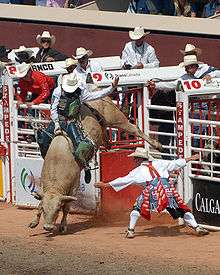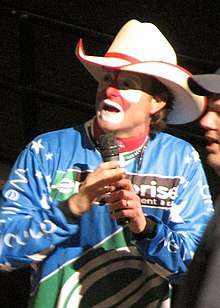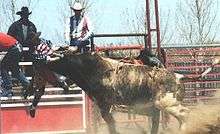Rodeo clown
A rodeo clown, bullfighter (in the United States, Canada, Australia and New Zealand) or rodeo protection athlete, is a rodeo performer who works in bull riding competitions. Originally, the rodeo clown was a single job combining "bullfighting"—the protection of riders thrown from the bull, as well as being an individual who provided comic relief. Today in the United States, the job is split into two separate ones: bullfighters who protect the riders from the bull, and entertainers (barrelmen) who provides comic humor. However, in other parts of the world and at some small rodeos, the jobs of rodeo rider protection and comic remain combined.


Tasks and skills
The primary job of the rodeo bullfighter is to protect a fallen rider from the bull by distracting it and providing an alternative target for the bull to attack, whether the rider has been bucked off or has jumped off the animal. These individuals expose themselves to great danger in order to protect the riders. To this end, they wear bright, loose-fitting clothes that are designed to tear away, with protective gear fitted underneath.[1] Rodeo clowns require speed, agility, and the ability to anticipate a bull's next move.[1] Working closely with very large, very powerful animals, rodeo clowns are often injured seriously, and, sometimes, fatally.
In some venues, rodeo bullfighters still wear clown make-up and some may also provide traditional clowning entertainment for the crowd between rodeo events, often parodying aspects of cowboy culture. But most modern bullfighters no longer dress as clowns, though they still wear bright, loose-fitting clothing. At larger events in the USA, the job is split, a bullfighter (sometimes two or more) protects the riders from the bull, and a barrelman (sometimes one person, sometimes two) provide comic humor.[2] Some barrelmen provide both comedy and support to bullfighters, but the job of a bullfighter is generally distinct from that of the comic.[3][4]
History
Rodeo clowns date to the beginnings of competitive rodeo in the early 1900s, when promoters hired cowboys to entertain the crowd between events or if the competition was delayed. These individuals began wearing oversized, baggy clothing and eventually developed more outlandish gear. When bull riding competition began to use ill-tempered Brahma bulls in the 1920s, the need for a person to distract the bull from fallen riders fell to the rodeo clown. The use of a barrel for protection began during the 1930s when a rodeo clown named Jasbo Fulkerson began to use a wooden barrel with a solid bottom.[5] In 1995, Earl W. Bascom was honored at age 89 as the oldest living rodeo clown in the world.[6] Bullfighting was reported as Wick Peth's profession in 1967,[7] and Jimmy Anderson was reported to have begun his career in 1975.[8]
In Australia, rodeo clowns were a part of rodeos and agricultural shows for many years. They were hired to entertain the spectators between events and to help manage the bullocks, steers or bulls in the arena.[9] In the 1930s, with the introduction of aggressive Brahman bulls and Brahman crossbreds, the job became much more serious.[1] In the late 20th century, acknowledging the great danger faced by the profession, the term bullfighter began to replace the name rodeo clown in formal use. The comedy aspect of clown work, as opposed to protection of rodeo athletes, began to disappear in some parts of the USA by the late 1970s.[10]
In 2003, bullfighters in the Professional Bull Riders (PBR) organization stopped wearing traditional rodeo clown make-up & outfits, and traded them for sport jerseys & shorts with corporate sponsor logos. This was also the case for barrelmen in the PBR, but they retained their make-up.
Technique
The bullfighters enter the rodeo arena on foot, before the bull is released from the bucking chute. They stand on either side of the chute as the bull is released and work as a team to distract the bull and thus protect the rider and each other.[1] Their role is particularly important when a rider has been injured, in which case the bullfighter interposes himself between the bull and the rider, or uses techniques such as running off at an angle, throwing a hat, or shouting, so that the injured rider can exit the ring. When a rider has been hung up, they face the extremely dangerous task of trying to free him, with one team member going to the bull's head and the other attempting to release the rider.[1]
Typically, at larger rodeos, bullfighters work in groups of as little as two, and as many as four. The barrelman uses a large, well-padded steel barrel that he can jump in and out of easily, and the barrel helps to protect him from the bull.[5] In Australia, barrelmen generally do not use barrels.

All members of the protection team wear loose, baggy clothing. The comic may wear the most outlandish clothing in bright colors, which may include things like wearing an inflatable female costume, and uses noisy colorful props such as rubber chickens and exploding garbage cans.[5]
Typically, the barrelman carries a microphone and heckles the rodeo announcer, the crowd and anyone else he recognizes. During the bull riding event, the barrelman supports the bullfighters, including taunting the bulls by calling them names and waving props at them, usually from within the safety of the barrel.[5] Barrelmen may also tell jokes and use topical humor.
Freestyle Bullfighting
Bullfighting has grown in popularity, so that in addition to being a job in its own right, it is a competitive event at rodeos around the United States. When not working to protect bull riders, rodeo bullfighters also have their own performances known as Freestyle bullfighting or American bullfighting.[11] Instead of bucking bulls, fighting bulls are used in these events. They are turned into the arena and the bullfighter works with the animal, evaluated based upon the aptitude he displays in controlling and maneuvering the bull, precision in jumping the bull, contact with the bull, and handling of the barrel.[12] Similar skills are sometimes displayed at traditional rodeos in intermission acts.[1] A typical format is a 60- or 70-second encounter between bull and bullfighter, in which the bullfighter scores points for various maneuvers.[13][14] In contrast to the older sport of Spanish bullfighting, no harm is done to the bull in rodeo bullfighting.[13]
Recognition
Since 2015, the Bullfighters Only Tour has crowned a definitive world champion each December in Las Vegas. From 1981–2000, Wrangler Jeans sponsored the Bullfighter of the Year contest at the National Finals Rodeo,[15] The California Cowboys Professional Rodeo Association designates a Bullfighter of the Year annually.[16] Other titles include the American Cowboys Association Freestyle Bullfighting Champion and the Ultimate Challenge Freestyle Bullfighting Champion.[17] Schools exist to provide training for potential rodeo bullfighters.[1]
References
- Groves, Melody; "Ropes, Reins and Rawhide", University of New Mexico Press, 2006, ISBN 0-8263-3822-4
- "Bronco riding cowboys embody the spirit of those who transformed West". Los Angeles Times. 1980-07-31. p. G14.
- Buss, Dale D. (1981-04-02). "Our Nimble Writer Faces an Angry Bull, Lives to Tell Tale". The Wall Street Journal. p. 1.
- "Rodeo Clown and Barrelman". Retrieved 2013-01-21.
- Hollman, Holly. "Clowning around in arena is a century-old tradition" Decatur Daily, March 26, 2007
- Vernal Express (August 30, 1995) "World's oldest living rodeo clown and bullfighter dies"
- Taylor, Ron (1967-11-12). "Matador in Baggy Pants". Los Angeles Times. p. M35.
- Clifton, Guy (2008-12-08). "Late bullfighter Jimmy Anderson is remembered by rodeo community". ESPN.com. Retrieved 2009-07-07.
- Hicks Jenny, “Australian Cowboys, Roughriders & Rodeos”, CQU Press, Rockhampton, QLD, 2000
- Kendall, Pete (2009-06-15). "Clownin' around". Cleburne Times-Review. Archived from the original on 2012-07-23. Retrieved 2009-07-07.
- Professional Bullfighters
- "The First Dickies National Championship Bullfighting Qualifier Kicks Off In Cheyenne". Professional Bull Riders. July 21, 2005. Archived from the original on December 25, 2017.
- Pressgrove, David. "Rodeo bullfighting comes to Craig". Craig Daily Press. www.craigdailypress.com. Archived from the original on July 8, 2011. Retrieved December 25, 2017.
- "SuperBull tour comes to Amarillo". Amarillo Globe-News. 2002-01-18. Retrieved 2009-07-08.
- Hoffman, Brett (1995-01-22). "Rodeo clown Rob Smets keeps the audience in stitches while keeping fallen riders out of harm's way". Fort Worth Star-Telegram. p. 17.
- "Sidelines: Martin memorial bull ride scheduled". Oroville Mercury-Register. 2009-07-07. Retrieved 2009-07-07.
- Waters, Betty (2009-06-13). "No Clowning Around: Protecting Bullriders Is Serious Business". TylerPaper.com. Retrieved 2009-07-07.